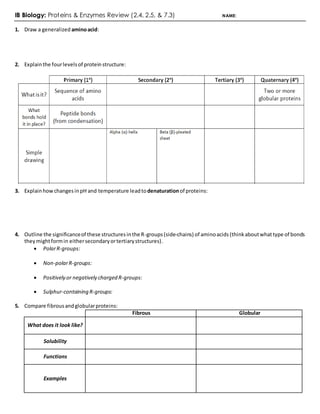
IB Proteins & Enzymes Review (2.4-2.5-7.3)
- 1. IB Biology: Proteins & Enzymes Review (2.4, 2.5, & 7.3) NAME: 1. Draw a generalized aminoacid: 2. Explainthe fourlevelsof proteinstructure: 3. ExplainhowchangesinpH and temperature leadtodenaturationof proteins: 4. Outline the significanceof these structuresinthe R-groups(side-chains) of aminoacids (thinkaboutwhattype of bonds theymightformin eithersecondaryortertiarystructures). PolarR-groups: Non-polarR-groups: Positively or negatively charged R-groups: Sulphur-containing R-groups: 5. Compare fibrousandglobularproteins: Fibrous Globular What does it look like? Solubility Functions Examples
- 2. 6. Proteinsare usedonthe plasmamembrane andfor otherdiverse functions.Complete the table below: ProteinFunction Example What doesit do? Gas / Nutrient Transport Catalyst/ Enzyme Immunity/ Defense Hormones Structure / Tensile Strength Movement/ Muscle Contraction DNA Packaging 7. Complete the table describingthe functionsof the six specificproteinexample,below: ProteinExample Function Rubisco Insulin Immunoglobulin (Antibodies) Collagen Rhodopsin Spidersilk 8. Define the following: enzyme “globularprotein which actsas a catalystforbiological reactions” active site denaturation 9. List three examples of enzymes,withtheirfunctions. ________________________________________________________________________ ________________________________________________________________________ ________________________________________________________________________ 10. Explainenzyme-substratespecificity.Include adiagram: 11. State the functionof polarregions of aminoacidson the active site of the enzyme.
- 3. 12. Explainthe loweringof activation energy byenzymes. 13. Explainthe effectsof temperature,pHandsubstrate concentrationonthe rate of an enzyme-controlledreaction. Draw a sample graphin the space on the leftandthenexplain/describe onthe right: Temperature pH Substrate concentration 14. Explainthe industrial productionof lactose-free milk,including twoadvantagesof lactose-free milk:
